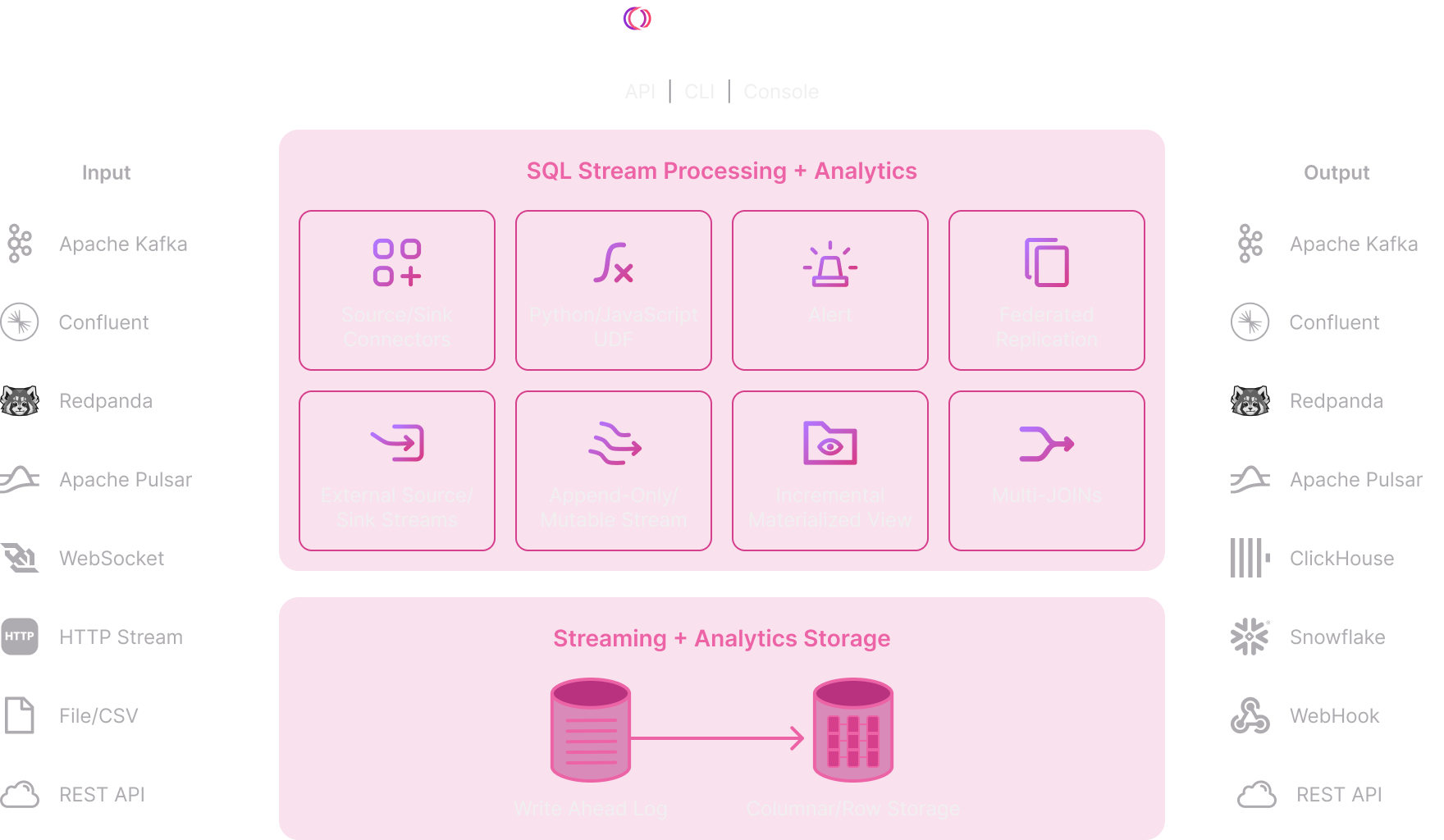Why Timeplus?
Timeplus simplifies stateful stream processing and analytics with a fast, single-binary engine. Using SQL as a domain-specific language and both row and column-based state stores, it enables developers to build real-time applications, data pipelines, and analytical dashboards at the edge or in the cloud, reducing the cost, time, and complexity of multi-component stacks.
Architecture: The Best of Both Worlds

Unified streaming and historical data processing
Timeplus streams offer high performance, resiliency, and seamless querying by using an internal Write Ahead Log (WAL) and Historical Store. The WAL ensures ultra-fast inserts and updates, while the Historical Store, optimized for various query types, handles efficient historical queries.
This architecture transparently serves data to users based on query type from both, often eliminating the need for Apache Kafka as a commit log or a separate downstream database, streamlining your data infrastructure.
Append-Only and Mutable Streams
Configure types of streams to optimize performance.
- Append-only streams: Excel at complex aggregations, storing data in a columnar format for faster access and processing.
- Mutable streams: Support UPSERTs and DELETEs, ideal for applications like Materialized Caches or GDPR compliance, using a row-based store optimized for fast data retrieval and query consistency.
Single Binary
Timeplus is a fast, powerful, and efficient SQL stream processing platform with no dependencies, JVM, or ZK. It runs in bare-metal or Kubernetes environments, from edge to cloud, using a single binary (~150MB).
Timeplus scales easily from edge devices to multi-node clusters, and with its Append-Only data structures and historical stores, some use cases may not need Kafka or a separate database at all.
Multi-JOINs and ASOF JOINs
Stream processing involves combining multiple data sources, and MULTI-JOINs are essential for enriching and correlating events in streaming queries. Timeplus allows you to run ad-hoc historical queries on the same data, reducing the need for denormalization in downstream data warehouses.
In many cases, Business Intelligence and analytical queries can be executed directly in Timeplus, eliminating the need for a separate data warehouse. ASOF JOINs enable approximate time-based lookups for comparing recent versus historical data.
Python and JavaScript UDF
We understand that SQL may not be able to express all business logic for streaming or querying. JavaScript and Python User Defined Functions (UDFs) and User Defined Aggregate Functions (UDAFs) can be used to extend Timeplus to encapsulate custom logic for both stateless and stateful queries.
With Python UDFs in preview, this opens up the possibility to bring in pre-existing and popular libraries, including data science and machine learning libraries!
External Stream, External Table
We want to simplify the experience of joining data from Apache Kafka and writing results out to data warehouses such as Clickhouse, or another Timeplus instance. Timeplus implements native integration to these systems in timeplusd via EXTERNAL STREAM (with Kafka and Timeplus) and EXTERNAL TABLE (with ClickHouse). No need for deploying yet another Connector component.
We understand that we cannot do this for all systems and for that, we have Timeplus Connector which can be configured to integrate with hundreds of other systems if needed.
Collection
With built-in External Streams and External Tables, Timeplus can natively collect real-time data from, or send data to, Kafka, Redpanda, ClickHouse, or another Timeplus instance, without any data duplication.
Timeplus also supports a wide range of data sources through sink/source connectors. Users can push data from files (CSV/TSV), via native SDKs in Java, Go, or Python, JDBC/ODBC, Websockets, or REST APIs.
Transformation
With a powerful streaming SQL console, users can leverage their preferred query language to create Streams, Views, and incremental Materialized Views. This enables them to transform, roll up, join, correlate, enrich, aggregate, and downsample real-time data, generating meaningful outputs for real-time alerting, analytics, or any downstream systems.
Routing
Timeplus allows data to be routed to different sinks based on SQL-based criteria and provides a data lineage view of all derived streams in its console. A single data result can generate multiple outputs for various scenarios and systems, such as analytics, alerting, compliance, etc., without any vendor lock-in.
Analytics and Alerting
Powered by SSE (Server-Sent Events), Timeplus supports push-based, low-latency dashboards to visualize real-time insights through data pipelines or ad-hoc queries. Additionally, users can easily build observability dashboards using Grafana plugins.
SQL-based rules can be used to trigger or resolve alerts in systems such as PagerDuty, Slack, and other downstream platforms.